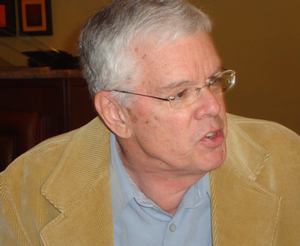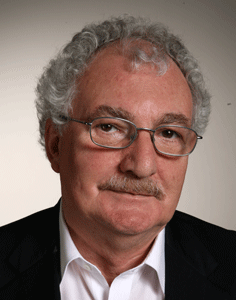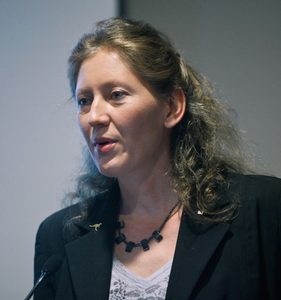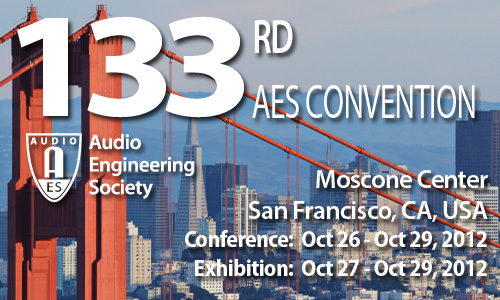
AES San Francisco 2012
Historical Event Details
Friday, October 26, 11:15 am — 12:15 pm (Room 121)
H1 - Popular Misconceptions about Magnetic Recording History and Theory—Things You May Have Missed over the Past 85 Years
Presenters:Jay McKnight, Magnetic Reference Lab - Cupertino, CA, USA
Jeffrey McKnight, Creativity, Inc. - San Carlos, CA, USA
Abstract:
• Who really discovered AC Bias? The four groups that re-discovered it around 1940, including one person you've probably never heard of.
• How does AC bias actually work?
• Is a recording properly described by "surface induction"?
• The story of the "effective" gap length of a reproducing head, and a correction to Westmijze’s Gap Loss Theory.
• Does Wallace’s “Thickness Loss” properly describe the wavelength response?
• Does disconnecting the erasing head make a quieter recording?
Saturday, October 27, 12:15 pm — 1:15 pm (Room 122)
H2 - The Evolution of Electrical Recording At RCA Victor Studios 1925–1953
Presenter:Nicholas Bergh, Endpoint Audio Labs - Burbank, CA, USA
Abstract:
This must-see presentation explores the first decades of electric recording by examining the technical evolution of the RCA Victor recording studios. The early commercial recording industry was comprised of only a few major studios, employing just a handful of recording personnel who used relatively secret equipment. Very little is left from the music industry to document the early electrical recording era—cryptic technical notations in recording ledgers, brief technical comments in memoirs, a few crude photos, and decades of secondhand lore. Since the few remaining Victor studio documents alone are not adequate in explaining what was going on behind the scenes, the focus of this research has been a number of alternative primary sources, for example the original engineering reports from Western Electric and RCA, manuals for the leased studio equipment, and modern tests of restored original recording equipment. Although these sources are not always definitive on their own, they become quite powerful when used together. This research helps address some of the important questions and misconceptions of this era that still face us today in the modern use and archival transfer of these recordings. Mr. Bergh will explain sound quality shifts during different years, the development of equalization standards, and session ledger notations. Exploring the evolution of RCA Victor also provides an important understanding of the evolution of the modern recording industry as a whole. The presentation will include images of the recording equipment used, as well as fascinating audio clips
Saturday, October 27, 1:15 pm — 2:15 pm (Room 111)
Historical Committee Meeting
Abstract:
Interested in committee activities? All are welcome.
Sunday, October 28, 10:45 am — 11:45 am (Room 122)
H3 - Lee de Forest: The Man Who Invented the Amplifier
Presenter:Mike Adams, San Jose State University - San Jose, CA, USA
Abstract:
After Lee de Forest received his PhD in physics and electricity from Yale University in 1899, he spent the next 30 years turning the 19th Century science he learned into the popular audio media of the 20th century. First he added sound to the wireless telegraph of Marconi and created a radiotelephone system. Next, he invented the triode vacuum tube by adding a control grid to Fleming’s two-element diode tube, creating the three-element vacuum tube used as an audio amplifier and oscillator for radio wave generation. Using his tube and building on the earlier work of Ruhmer and Bell, he created a variable density sound-on-film process, patented it, and began working with fellow inventor Theodore Case. In order to promote and demonstrate his process he made hundreds of short sound films, found theaters for their showing, and issued publicity to gain audiences for his invention. While de Forest did not profit from sound-on-film, it was his earlier invention of the three-element vacuum tube that allowed amplification of audio through loudspeakers for radio and the movies that finally helped create their large public audiences.
Sunday, October 28, 1:30 pm — 4:00 pm (Off-Site 2)
H4 - The Egg Show: A Demonstration of the Artistic Uses of Sound on Film
Dolby Laboratories’ Theater
Presenter:Ioan Allen, Dolby Laboratories Inc. - San Francisco, CA, USA
Abstract:
The Egg Show is a two-hour entertaining and evocative look at the influences of sound mixing on motion picture presentation. This educational and exquisitely entertaining survey of sound design and acoustical properties in film has been presented at many industry events, film festivals, technology seminars, and film schools with great success. With pictures of eggs ingeniously illustrating his points, and an array of 35mm clips, Mr. Allen explains mixing and editing techniques that sound designers and filmmakers have developed over the years. Many film examples are used, each of which has been chosen to demonstrate a different mixing issue. You will see how film sound mixers highlight a conversation in a crowd scene, inter-cut music to film and create artificial sound effects that sound more real on film than on a live recording. Numerous slides enhance the lecture, most of which use photographs of eggs to illustrate the artistic uses of sound on film.
Location
This event will be held at Dolby Laboratories’ Theater, a multi-format projection room/recording studio complex within Dolby’s South-of-Market Dolby headquarters. The facility was designed as an ideal listening and viewing environment for film, recorded sound, and live presentations.
A limited number of $10 tickets will be available exclusively to registered convention attendees at the tours counter in the main lobby at Moscone. The marked bus will depart at 1:30 for the short ride to Dolby.
About the Speaker
In addition to his 1987 Oscar, Ioan Allen has earned Scientific and Engineering Awards from the Academy of Motion Picture Arts and Sciences. An AES Fellow, and recipient of the AES Silver Medal, Mr. Allen spearheaded the introduction of breakthrough film audio formats which have revolutionized the film sound experience. He is a Fellow of SMPTE and BKSTS and active in U.S. and world standards organizations. In 1985 he received the Samuel L. Warner Award for contributions to motion picture sound.
Monday, October 29, 9:00 am — 10:30 am (Room 133)
H5 - The Replay of Historical Magnetic Tape—More than Pressing the Play Button
Presenter:Nadja Wallaszkovits, Phonogrammarchiv, Austrian Academy of Science - Vienna, Austria
Abstract:
This fascinating presentation discusses the various process challenges involved with the transfer of historical magnetic audio tapes. Focusing on the digitization of collections from the very early years of magnetic recording, for example the earliest tapes from Portugal and Norway, Nadja Wallaszkovits shows the various stages of preservation, handling, and reproduction of important original tapes from the early days of magnetic recording. Beginning with an overview of early magnetic tape developments, the original tape recorders and their specific parameters are introduced. Next, the practical handling of critical tapes is outlined. Based on an analysis of the physical and chemical preservation status of individual tapes, the choice and adjustment of the replay equipment and parameters are covered. The problems of tape carrier handling and physical as well as chemical restoration are outlined, along with discussions on optimizing head azimuth, tape-to-head contact, tape speed, and tension. All are important for optimum signal recovery.



